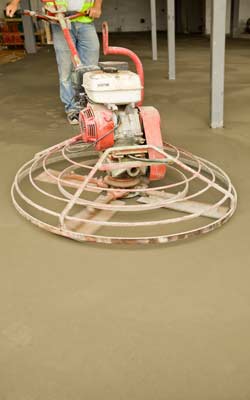 Power trowels offer a great option for smoothing large concrete slabs and getting the slab to a hard, level finish. But timing is key, and trying to rush the concrete power trowel process can actually slow the project and add cost by limiting the porous nature of the slab that allows the concrete moisture to evaporate from the surface during the drying process. That glossy, smooth surface can actually retard the concrete drying process and extend the drying time required to meet a concrete moisture specification for a flooring installation.
Power trowels offer a great option for smoothing large concrete slabs and getting the slab to a hard, level finish. But timing is key, and trying to rush the concrete power trowel process can actually slow the project and add cost by limiting the porous nature of the slab that allows the concrete moisture to evaporate from the surface during the drying process. That glossy, smooth surface can actually retard the concrete drying process and extend the drying time required to meet a concrete moisture specification for a flooring installation.
Timing the finishing process is crucial to the end quality of a concrete slab. Newer technology and equipment make it easier to start the concrete finishing process too quickly; but the risks of compacting and delamination also increase, particularly when heavier power trowel equipment is taken onto lightweight concrete applications. A combination blade allows the operator to level and finish in one step, but the risk of overworking the concrete in that initial stage increases. The sharper the angle of the blade, the more pressure it exerts on the concrete and the slicker that surface becomes. High blade speeds also “burn” the slab surface, sealing over the naturally porous nature of concrete and sealing in the moisture that needs to be released for the slab to dry to allow for direct installation of a floor covering without the need of a moisture barrier system.
How is this a problem for your building project?
When power troweling overworks the concrete surface, it in effect compresses the top layer of the slab, closing up the naturally porous “vents” or pathways in the aggregate that allow moisture within the concrete slab to move to the surface and to evaporate out of the slab. The surface of the concrete slab actually becomes its own moisture barrier and retards the drying process. Impaired drying capabilities can prolong your project schedule or add cost by demanding additional remedial steps to prepare for flooring installation. The trade-off is usually either performing remedial steps like having to regrind the surface to allow sufficient drying causing an extended delay, or applying a moisture barrier system to prevent a flooring failure in the future due to the high concrete moisture content.
The power trowel finish should always be carefully specified with the end flooring application in mind. For example, float pans typically do a better job of “breaking open” the concrete surface, producing a flat, level floor while allowing moisture to evaporate at a reasonably steady rate. For a typical flooring application, this surface is sufficient and actually provides a small amount of tooth for adhesive applications to adhere. For a painted or special finish application, a slicker surface may be required, but sufficient drying time must also be allowed. There must be a balance between completing troweling before the concrete sets too firmly to work and allowing the nature of the drying slab to work to its best advantage. Finish troweling at the expense of a drying schedule is never the best choice.
Even with expert finish troweling, once a poured concrete slab is finished, drying progress must still be monitored, particularly when a flooring installation is scheduled. The ASTM F2170 standard recommends relative humidity (RH) testing using in situ probes so that an accurate determination of the moisture conditions below the troweled surface can be available. Power troweling, and other forms of finishes are one of the many reasons why surface moisture meters or surface-based tests such as calcium chloride are inadequate – and in lightweight aggregate applications, specifically disallowed by ASTM F1869 (read more here) – for determining flooring application readiness.
Power troweling can mean a smooth, flawless finish for a poured concrete slab. But don’t let that shiny surface blind you to the true readiness of the concrete below.




Ron,
Great article! But is it okay to “burn” the slab surface smooth if there will be no floor covering? We want the look of sealed concrete floors in our house! Any tips?
Thanks in advance!
Chris,
If you are not planning on installing any moisture-sensitive product on the concrete, then don’t worry about heavy power-troweling. You will probably have a real nice-looking concrete floor!
Thanks.
Ron
Ron,
I want to put an epoxy floor down in my garage. I believe it was power trowelled, do I need to grind through the top layer before epoxy coatings?
The manufacturer of the epoxy coating should have specifications for the correct concrete profile. They may indeed require a scarified (rough) surface.
They probably also specify a maximum acceptable internal (within the concrete at about 40% depth) relative humidity or surface moisture content.